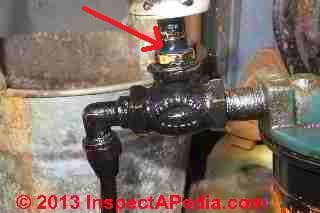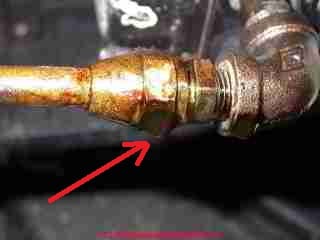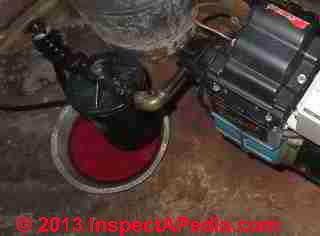 Heating Oil Line Feed Piping Leaks
Heating Oil Line Feed Piping Leaks
- POST a QUESTION or COMMENT about leaks or installation problems in heating oil piping for oil-fired heating equipment & water heaters
Heating oil piping leaks in the oil burner supply & return piping: causes & effects of leaks in heating oil supply piping at fittings, valves, or other locations.
Heating oil pipe leaks out (fuel oil leaks), oil piping leaks in (air in the system) are dangerous in several regards, as a leak in oil burner feed piping can cause a puffback or complete loss of heat.
This document lists other important safety or oil-fired equipment operational defects in home and light commercial heating oil storage and piping systems.
InspectAPedia tolerates no conflicts of interest. We have no relationship with advertisers, products, or services discussed at this website.
- Daniel Friedman, Publisher/Editor/Author - See WHO ARE WE?
Heating Oil Line Leaks - Oil Line leaks found - can lead to oil heat system puffback and loss of heat
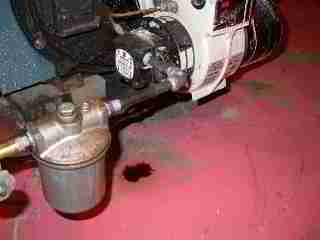 This article discusses leaks in the oil piping line(s) between an oil storage tank and the oil burner(s) that it supplies.
This article discusses leaks in the oil piping line(s) between an oil storage tank and the oil burner(s) that it supplies.
Watch out: leaks in heating oil appliance piping or filters can be much more serious than just a drip spot on the floor.
The same leak that allows oil to drip out of the oil filter or piping connections allows air to be drawn into the system when the oil fuel unit (oil pump for the water heater, oil fired boiler or furnace) is running.
That air leak into the system results in improper oil burner operation, soot clogging, and even a loud bang at oil burner start-up or worse, a dangerous puffback.
[Click to enlarge any image]
A separate article
at OIL TANK FILL / VENT PIPE LEAK REPAIRS discusses leaks in the oil tank fill and vent pipes.
How to spot heating oil line piping leaks by eye
Look for a drip area below heating oil piping, connectors, the oil filter, anywhere from the oil tank to the oil burner. To make detection of oil line leaks easier, be sure that surfaces below these areas are clean of loose dirt and debris.
To confirm that a suspected leak is dripping it may help to place a clean paper towel on the floor below the suspected drip point. Monitor for oil drops on the paper towel.
In our photo above, the oil line leak is a bit obvious as the property owner has left an aluminum pie plate to catch dripping heating oil!
The oil leak at the oil safety valve (below left) was present on the oil line supplying the oil burner whose smoky operation could be seen from outdoors (below right).
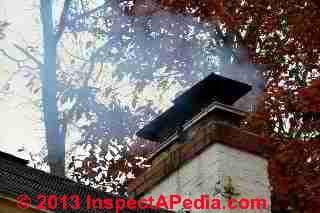
While the smoky chimney visible at above right cleared up after an hour or so of oil burner operation, we suspect that because the smoky operation went on for at least fifteen minutes after initial oil burner start-up, the oil burner was not operating properly.
Further investigation by a heating service tech might trace the burn-off of oil accumulated in the combustion chamber to that leaky OSV shown at above left.
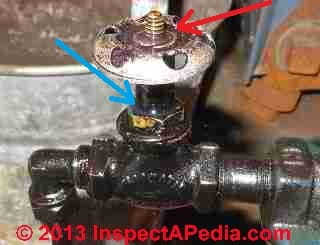
Why would this happen? It may come as a surprise but drawing air into the oil burner from a leak in the oil line can leave an air bubble in the oil burner nozzle.
When the oil burner shuts down the pressure inside the nozzle area drops from 100 psi or more down to ambient pressure of just a few pounds.
Photo at left: close-up shows heating oil seeping out at the very top of the oil safety valve (red arrow) and at the valve stem base (blue arrow).
Locating the highest point at which heating oil is visible on an oil-soaked component usually is a good clue about the actual point of leakage.
This oil line safety valve (OSV) is leaking through the valve core. It needs to be replaced. [Click to enlarge any image]
The reduction in pressure causes that little air bubble to expand, pushing extra oil out of the oil burner nozzle where it dribbles into the oil heating system boiler or furnace combustion chamber.
The next time the oil burner starts-up this un-burned oil residue forms a mini explosion - you may hear a sort of "bang" when the oil burner starts.
Watch out: This malfunction can lead to a serious puff back blowing soot into the home, or worse.
This is an unsafe condition caused by what looks like a tiny innocent drip such as the one we show in our photo above.
This item should be checked/corrected by your service person promptly.
See details at PUFFBACKS, OIL BURNER
Heating Oil Leaks in the Heating Oil Line at the Oil Filter
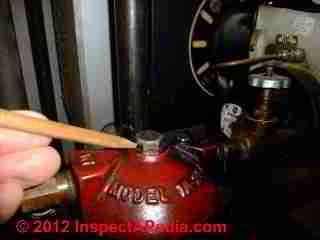
In detail at OIL FILTER LEAK POINTS we describe the sources of leaks at and around the heating oil filter. Excerpts are below.
Leaks at the heating oil filter can occur at a variety of locations - everywhere that there is a threaded fitting or connector, including:
- At the center bolt head that secures the filter top to the filter canister base. A new fiber washer should be installed under this bolt head during oil filter change. (Pencil points to the center bolt in our photo at left).
- At the air bleed screw on the outlet end of the heating oil filter cartridge. A new fiber washer should be installed under this little screw head during oil filter change. New washers are included with each new oil filter cartridge.
- At the gasket between the oil filter cartridge base and filter top. This gasket is replaced during oil filter change.
- At the inlet or outlet fittings at either end of the oil filter cartridge cap.
- At nearby heating oil piping fittings that may have been disturbed during oil filter disassembly, cleaning, and cartridge replacement.
Oil piping leak at the copper piping flare fitting
As we explain in this article, and as we elaborate
at OIL BURNER INSPECTION & REPAIR
as well, oil leaks in the oil piping and filter system can not only spill oil, but can lead to loss of heat, improper oil burner operation and even a puffback.
At left we illustrate an active oil leak at a flare fitting.
We don't know without further investigation if this leak is because the flare nut is loose or if it's because the copper flare was cracked or improperly made, or finally, if it's because of a notch or scratch on the brass mating surface of the flare.
Try gently tightening the fitting and then clean it thoroughly and check for leaks.
What to Do About Heating Oil Line Leaks: How Urgent is Repair?
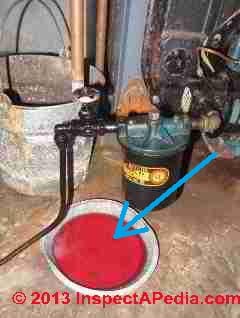 This example of inspection report language where leaks or drips are found in heating oil piping is based on the inspection and photographs shown above.
This example of inspection report language where leaks or drips are found in heating oil piping is based on the inspection and photographs shown above.
Watch Out: unsafe condition and risk of loss of heat at the building:
We saw a heating oil line leak at oil line piping and fittings at the oil burner: the oil safety valve was wet with heating oil as were nearby oil piping fittings, and a pie plate on the floor contained about 1/2" of fresh heating oil. [Photo at left]
We also observed improper heating system operation: the burner ran very smoky (photos below) for a protracted interval after start-up, suggesting a quantity of un-burned oil in the combustion chamber.
That condition can be caused by air leaks into the heating oil piping system.
Oil leaks may be hazardous and also, as air may be drawn into the oil line when the fuel unit is pumping, they can lead to improper and unsafe system operation and even loss of heat in the building.
The urgency of this repair depends in part of other on-site observations such as the state of operation of the heating system. Given the smoky chimney (photo below) that was observed at oil burner startup and for a protracted interval after start-up, this system is not operating properly.
Action: A heating service call should be scheduled immediately.
This is a bit more detail than many home inspectors prefer to provide to their customer. I include this level of information to be sure that the reader understands the issue and is forewarned to reduce the risks of failure to act or failure to obtain a proper repair. The minimum that might be reported is below:
Watch Out: We saw evidence of a heating oil line leak at oil line piping and fittings at the oil burner:
A heating service call should be schedule immediately to reduce the chances of loss of heat and unsafe heating system operation.
Why do we call this heating oil line leak a safety concern?
Oil line leaks can lead to a dangerous puffback at the oil burner that in turn risks a very messy soot-up of the building interior and in less common but possible cases, a fire, or a blow-off of the flue vent connector between the heating appliance and the chimney, subsequently venting combustion gases (and possibly dangerous carbon monoxide) into the building.
Inspection & Pressure Tests (Vacuum Tests) of Heating Oil Piping
Reader Question: Is it normal practice to pressure test fuel lines when a new boiler has been fitted?
Is it normal practice to pressure test fuel lines when a new boiler has been fitted? We have an outdoor boiler that runs on a 2 pipe system as the storage tank is below the boiler.
The oil tank lines are buried as the distance between boiler & storage is 15-20 m. We reported a vast increase in oil consumption after installation, would it be the normal course of action to then pressure test 'supply & return' lines? - Mark 5/29/12
Reply: How pressure & vacuum gauges are used on heating oil lines to check for leaks or fuel unit troubles
Mark, it is normal practice to inspect oil piping for leaks at all of its fittings & connections for leaks after a new installation, and there are indeed vacuum measurement tests (not pressure tests) that can be conducted that indicate an air leak into the oil supply line line (or oil leaks out when the fuel unit is not running).
But in my experience oil line vacuum tests are not performed as a matter of course but rather when a problem is under diagnosis, such as improper oil burner operation. And in my experience oil supply & return lines between the oil tank and the oil burner are not pressure tested. As I explain here, pressure testing those lines runs into some practical difficulties.
Similarly, a vacuum gauge installed on the heating oil supply line, often at or near the oil filter assembly, can help diagnose a leak in the supply piping itself.
Unfortunately in a two-pipe system we don't install and cannot use a similar gauge on that second line to check for leaks.
In a two-pipe oil line system, the return line is never under vacuum, only under pressure when excess oil from the fuel unit is cycling back to the oil tank. Because the exit end of that pipe is open into the oil tank, it is not and cannot be "pressure tested" without some disassembly and the fitting of a plug at the line's outlet end.
At OIL PUMP FUEL UNIT we include a detailed explanation of how to read a pressure gauge on the oil piping system (at the fuel unit) to diagnose a leak or similar problem at the fuel unit.
De-Aerator Problems with Air Leaks in Oil Line Piping
This discussion has moved to OIL SUPPLY & RETURN LINE DE-AERATORS Tigerloop™
...
Continue reading at OIL LINE PIPING LEAK CAUSES or select a topic from the closely-related articles below, or see the complete ARTICLE INDEX.
Or see OIL LINE PIPING LEAK FAQs - questions & answers about finding and fixing oil piping leaks that were posted originally on this page.
Or see these
Recommended Articles
- OIL LINE AIR REMOVAL PROCEDURE
- OIL LINE BUZZ & VIBRATION CURE
- OIL SUPPLY & RETURN LINE CONTROLS & VALVES
- OIL SUPPLY LINE CHECK VALVES
- OIL LINE CLOGGING FIX
- OIL SUPPLY & RETURN LINE DE-AERATORS Tigerloop™
- OIL SUPPLY LINE PIPING LEAKS
- OIL LINE PIPING LEAK CAUSES
- OIL LINE QUICK STOP VALVES
- OIL SUPPLY LINE SAFETY VALVES, OSVs
- OIL SUPPLY LINE SAFETY VALVE TURN DIRECTION to OPEN or SHUT
- OIL LINE VACUUM & PRESSURE TESTS
- OIL SUPPLY LINE VACUUM-ACTIVATED OSVs & PRVs
Suggested citation for this web page
OIL SUPPLY LINE PIPING LEAKS at InspectApedia.com - online encyclopedia of building & environmental inspection, testing, diagnosis, repair, & problem prevention advice.
Or see this
INDEX to RELATED ARTICLES: ARTICLE INDEX to HEATING OIL, OIL BURNERS, OIL FIRED HEATERS, OIL TANKS
Or use the SEARCH BOX found below to Ask a Question or Search InspectApedia
Ask a Question or Search InspectApedia
Try the search box just below, or if you prefer, post a question or comment in the Comments box below and we will respond promptly.
Search the InspectApedia website
Note: appearance of your Comment below may be delayed: if your comment contains an image, photograph, web link, or text that looks to the software as if it might be a web link, your posting will appear after it has been approved by a moderator. Apologies for the delay.
Only one image can be added per comment but you can post as many comments, and therefore images, as you like.
You will not receive a notification when a response to your question has been posted.
Please bookmark this page to make it easy for you to check back for our response.
IF above you see "Comment Form is loading comments..." then COMMENT BOX - countable.ca / bawkbox.com IS NOT WORKING.
In any case you are welcome to send an email directly to us at InspectApedia.com at editor@inspectApedia.com
We'll reply to you directly. Please help us help you by noting, in your email, the URL of the InspectApedia page where you wanted to comment.
Citations & References
In addition to any citations in the article above, a full list is available on request.
- [1] "Fuel Oil Piping and Storage", 2006 Mechanical Code, Chapter 13, International Code Council, 500 New Jersey Avenue, NW, 6th Floor, Washington, DC 20001, Tel: 888-ICC-SAFE (422-7233); Website: iccsafe.org/, Email: webmaster@iccsafe.org, Customer Store (buy publications) 800-786-4452. Also see 2009 International Codes and 2012 International Codes.
- [2] "The application of a continuous leak detection system to pipelines and associated equipment", Sandberg, C.
Raychem Corp., Menlo Park, CA, Holmes, J. ; McCoy, K. ; Koppitsch, H, Industry Applications, IEEE Transactions on, Sep/Oct 1989, Vol. 25 No. 5, pp. 906-909, ISSN : 0093-9994 INSPEC Accession Number: 3582593 Digital Object Identifier : 10.1109/28.41257, Abstract:
An overview of classical leak detection systems is given and the engineering basis of a novel type of detector is examined. This system is a flexible hydrocarbon-sensing cable that can be installed along pipelines, in double-containment tanks and piping, or in trenches to detect and locate leaks of common industrial hydrocarbon solvents or fuels while ignoring the presence of water. The simple electrical circuit that locates and detects a leak anywhere along the length of the sensor is also described - [3] "A Case Study of a Large Scale Precision [oil or fuel] Tank Testing Program", Diane H. Heck, Tetra Tech Richardson, Newark, Delaware, web search 4/27/12, original source: info.ngwa.org/GWOL/pdf/870143411.PDF, copy on file as /heating/OIl Tanks UST/Tank_Test_Heck_870143411.pdf
- [4] "An Engineering Guide to Modern Fuel Systems", Critical Fuel Systems, division of BFS Industries, LLC www.criticalfuelsystems.com, 200 Industrial Drive, Butner, NC 27509, (919)575-6711, retrieved 12/30/2013 original source: http://www.criticalfuelsystems.com/wp-content /uploads/2010/05/Design-Guide-print-22.pdf
- Audels Oil Burner Guide, Installation, Servicing, Repairing, Frank D. Graham, 1940's edition (obsolete). Updated versions of this guide are available in various editions, 1947, 1950, 1955, 1958, 1959, 1962, 1965, 1967, and at prices from around $3.00 to nearly $70.00 - useful for simple, clear, but not current, explanation of how heating equipment works. The original retail price was $1.00.
- Bottini Fuel service, 4/26/2011. Bottini Fuel is a residential and commercial heating oil distributor and oil heat service company in Wappingers Falls, NY and with offices in other New York locations. Bottini Fuel, 2785 W Main St, Wappingers Falls NY, 12590-1576 USA, Tel: (845) 297-5580 Web" bottinifuel.com/contact/
- Dave Ferris - M&S Environmental Systems, Dutchess County, New York. Mr. Ferris was an HVAC expert. Personal communication to DJF 1987. Remove the firematic or fusible oil supply line valve on return oil-line side - in case of fire if this one closes first the pump continues to run, blows its seal, and sprays oil all over the fire. Proper installation is to have a fusible link valve only on the supply side, and to install a check valve on the return line to prevent back-siphonage from the tank.
- "HUD Regulation for Manufactured Homes; Requirement that Heat-Tape not include a GFCI [ copy on file as /plumbing/GFCI_Heat_Tapes_HUD_CPSC_Letter1994.pdf ] - ", Meeting Log, US CPSC, HUD, Dennis McCoskrie, ESEE, 2/14/1994
- Our recommended books about building & mechanical systems design, inspection, problem diagnosis, and repair, and about indoor environment and IAQ testing, diagnosis, and cleanup are at the InspectAPedia Bookstore. Also see our Book Reviews - InspectAPedia.
- In addition to citations & references found in this article, see the research citations given at the end of the related articles found at our suggested
CONTINUE READING or RECOMMENDED ARTICLES.
- Carson, Dunlop & Associates Ltd., 120 Carlton Street Suite 407, Toronto ON M5A 4K2. Tel: (416) 964-9415 1-800-268-7070 Email: info@carsondunlop.com. Alan Carson is a past president of ASHI, the American Society of Home Inspectors.
Thanks to Alan Carson and Bob Dunlop, for permission for InspectAPedia to use text excerpts from The HOME REFERENCE BOOK - the Encyclopedia of Homes and to use illustrations from The ILLUSTRATED HOME .
Carson Dunlop Associates provides extensive home inspection education and report writing material. In gratitude we provide links to tsome Carson Dunlop Associates products and services.


